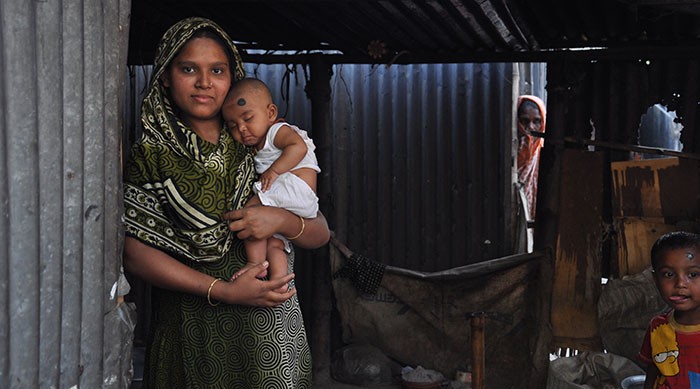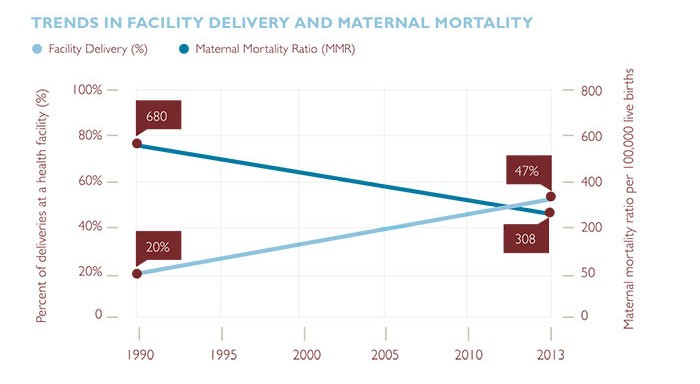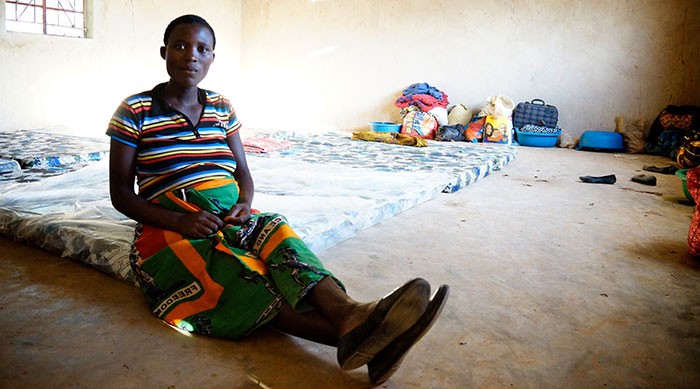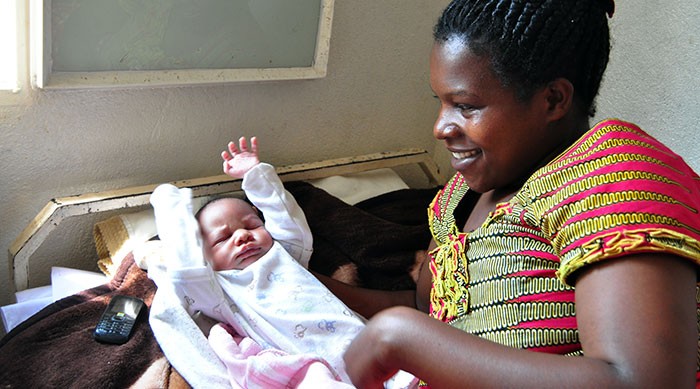- What We Do
- Agriculture and Food Security
- Democracy, Human Rights and Governance
- Economic Growth and Trade
- Education
- Ending Extreme Poverty
- Environment and Global Climate Change
- Gender Equality and Women's Empowerment
- Global Health
- Water and Sanitation
- Working in Crises and Conflict
- U.S. Global Development Lab
- CHILD HEALTH
- IMMUNIZATION
- MATERNAL HEALTH
- NEWBORN HEALTH
- WATER, SANITATION AND HYGIENE

“Women are not dying of diseases we cannot treat … they are dying because societies have yet to make the decision that their lives are worth saving.”
—Professor Mahmoud Fathalla, MD, PhD, Chair of the WHO Advisory Committee on Health Research
In the 25 U.S. Agency for International Development (USAID) priority countries, the maternal mortality ratio decreased by more than half over the past two decades. Despite such substantial progress, the World Health Organization (WHO) reports that 830 women still die every day from preventable causes related to pregnancy. Many of these women are from poor communities or rural areas and do not deliver in a facility – one of the most effective ways to ensure that women have access to the care and commodities needed to ensure the safety of both mother and child.
A Global Priority
Organizations throughout the world are aligning around the shared goal of ending preventable maternal mortality. In 2014, with technical input from USAID, a 2030 global target of fewer than 70 maternal deaths per 100,000 live births was adopted by WHO and representatives from more than 30 countries. In June of that year, USAID outlined its support for this goal in the report Ending Preventable Maternal Mortality: USAID Maternal Health Vision for Action. The Vision emphasizes equity, sustainability, country ownership, capacity building, innovation, and collaboration across disciplines and sectors to end preventable maternal mortality.

Numerous other adverse health consequences result from inadequate access to affordable, high-quality, respectful maternal health care. Roughly 10 percent of the 189 million women who are pregnant annually suffer a maternal complication during pregnancy or in the intrapartum period, and up to 40 percent may have morbidities or disabilities that are attributable to pregnancy or birth. Poor maternal health not only harms women and their children, but it also negatively interferes with women’s ability to contribute productively to their communities and societies. The financial costs of preventable maternal complications and the resultant problems for newborns place an added strain on families and society.
As outlined in USAID’s maternal health vision for action, discrimination often infringes on a woman’s right to affordable, high quality, respectful maternal health care, depending on her age, marital status, or other societal factors. Many women lack decision-making authority, while others may lack access to the financial resources needed for quality maternal health services. Additionally, many women report an unmet need for family planning services, which could prevent one-third of maternal deaths annually. Efforts to reduce maternal mortality must take these factors into consideration.

USAID’S Response
USAID concentrates its efforts to end preventable maternal mortality in 25 priority countries, together accounting for more than two thirds of maternal deaths worldwide and half of the global unmet need for family planning. These countries were selected due to the severity of maternal mortality exhibited, level of country commitment, USAID health program presence, and opportunities for partnership. In these 25 priority countries, USAID efforts to end maternal mortality are founded on three interdependent components:
Enabling and mobilizing individuals and communities. The community is an essential part of any health system. When women have access to high-quality care and trust their providers, they seek out care for themselves and their families. USAID supports programs to improve individual, household, and community behaviors and norms surrounding maternal health and decision-making. In addition, USAID partners with community leaders, local and national governments, and private sector organizations to improve the equity of access to services for the most vulnerable women.
Advancing quality, respectful care. USAID emphasizes the integration of family planning with maternal care services, and the scale-up of quality maternal and fetal care services through integrated, comprehensive strategies that look at health systems as a whole. USAID targets a variety of indirect causes that contribute to maternal mortality. The Agency also is working to increase focus on maternal morbidity and disability in partner countries. Throughout each of these specific areas of focus is an emphasis on respectful maternity care that promotes women’s knowledge and choice of care options.
Strengthening health systems and continuous learning. Through both public and private sector partnerships, USAID works to strengthen countries’ health systems holistically, at all levels of operation. Monitoring systems provide invaluable data on past and current progress that are then used to refine and improve health systems. In addition, USAID promotes innovation and research in both policies and programs and works to scale up high-impact interventions.
USAID’s ultimate goal to end preventable maternal mortality within a generation is a bold vision, but it is one that now has the support of key partners from around the globe. Through a focus on high-burden countries, collaboration with a wide array of partners, emphasis on improved access to and quality of care and referral systems, and systems for holding governments accountable, the vision is achievable.
Examples of our Work
Advancing quality, respectful care involves not only improving care for women but also the working conditions for providers. In Malawi, the poor status and substandard working conditions of midwives prompted the USAID-funded Health Policy Project to launch a “Happy Midwives for Happy and Healthy Mothers” campaign, drawing attention to midwives’ plight and its impact on the provision of high-quality care. In 2013, as a result of the project’s advocacy, the Ministry of Health changed the title of its Directorate of Nursing to the Directorate of Nursing and Midwifery, highlighting the important role that midwives play in Malawi’s health system.
The Saving Mothers, Giving Life partnership, of which USAID is a founding partner, is an integrated health systems approach that addresses the three primary delays associated with maternal and newborn health: the delay in seeking services, the delay in reaching care, and the delay in receiving high-quality care at a health facility. The public-private partnership’s mid-initiative report announced a 45 percent reduction in maternal mortality in target facilities in Uganda and a 53 percent reduction in Zambia. The remarkable success of the initiative has led to its expansion into additional districts in Uganda and Zambia, as well as into the Cross River State of Nigeria.

In October of 2015, USAID announced a 5-year expansion of the Saving Lives at Birth Partnership, which supports the development and scale-up of potentially transformative innovations that address the leading causes of mortality around the time of birth. To date, the Saving Lives at Birth Grand Challenge has funded 81 innovations, including the Odon device for obstructed labor, a uterine balloon tamponade for postpartum hemorrhage, and a bubble continuous positive air pressure device for acute respiratory distress in newborns. These and other innovations have benefitted over 1.5 million mothers and newborns, saving at least 4,000 lives.
Photo Gallery

How can we save 600,000 women's lives by 2020?
Millions of women, globally, give birth without access to a health facility or skilled birth attendant. The Acting on the Call report details how to increase access to health care during delivery by 2020 for 38 million women in 25 priority countries. Photo credit: Thomas Cristofoletti/USAID.

Voluntary family planning is the most effective intervention
USAID works with governments around the world to make sure women have the ability to plan their families. Healthy timing and spacing of pregnancies could save 400,000 women by 2020. Photo credit: Amy Fowler/USAID

Help pregnant women get and stay healthy
The health of a mother during pregnancy has a direct impact on her child. Antepartum interventions like malaria prevention, better nutrition, and better antenatal care could prevent 5,000 maternal deaths by 2020. Photo credit: Amy Fowler/USAID.

Ensure women deliver with a skilled birth attendant
USAID is working to ensure women around the world can deliver their children in the presence of a skilled birth attendant and in a qualified and equipped facility. Increasing access to and quality of care during delivery could save 150,000 women by 2020. Photo credit: Karen Kasmauski/MCHIP.

New mothers require follow-up care
Postpartum care can help avoid or resolve postpartum hemorrhage, sepsis, and other complications related to childbirth. Follow-up care following delivery could save the lives of 40,000 women by 2020. Photo credit: Thomas Cristofoletti/USAID.

We will help 38 million women increase access to care during delivery
Learn more about the interventions that can help increase access to care for 38 million women and save 600,000 lives in the 2015 Acting on the Call report. www.usaid.gov/actingonthecall. Photo credit: Amy Fowler/USAID.
RESOURCES
Ending Preventable Maternal Mortality: USAID Maternal Health Vision for Action
USAID Acting on the Call: Ending Preventable Child and Maternal Deaths
USAID FY 2014 Annual Health Programs Annual Report to Congress
Saving Lives at Birth Partnership
Photo Gallery: USAID’s Efforts to End Preventable Maternal Mortality







Comment
Make a general inquiry or suggest an improvement.